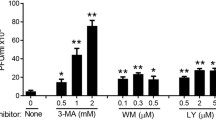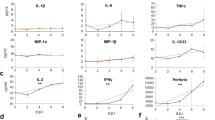Abstract
Brazil has experienced an increase in outbreaks caused by flaviviruses. The high incidence of dengue fever, the morbidity of Zika in children, and the high mortality of yellow fever have affected millions in recent years. Deciphering host-virus interactions is important for treating viral infections, and the mitogen-activated protein kinases (MAPK) are an interesting target because of their role in flavivirus replication. In particular, mitogen-activated protein kinase kinase (MEK), which targets extracellular-signal-regulated kinase (ERK), is necessary for dengue and yellow fever infections. In this study, we evaluated the role of the MEK/ERK pathway and the effect of the MEK inhibitor trametinib on the Asian ZIKV strain PE243 and the prototype African ZIKV strain MR766, addressing genome replication, morphogenesis, and viral release. ZIKV infection stimulated ERK phosphorylation in Vero cells at 12 and 18 hours postinfection (hpi). Trametinib showed sustained antiviral activity, inhibiting both ZIKV strains for at least four days, and electron microscopy showed probable inhibition of ZIKV morphogenesis. ZIKV PE243 can complete one cycle in Vero cells in 14 hours; genome replication was detected around 8 hpi, intracellular viral particles at 12 hpi, and extracellular progeny at 14 hpi. Treatments at 6-hour intervals showed that trametinib inhibited late stages of viral replication, and the titration of intra- or extracellular virions showed that the treatment especially affected viral morphogenesis and release. Thus, ZIKV stimulated ERK phosphorylation during viral morphogenesis and release, which correlated with trametinib inhibiting both the signaling pathway and viral replication.






Similar content being viewed by others
Data availability
Viral samples will be made available upon request.
References
Valencia HJ, de Aguiar MCAM, Costa MA et al (2021) Evaluation of kinase inhibitors as potential therapeutics for flavivirus infections. Arch Virol 166:1433–1438. https://doi.org/10.1007/s00705-021-05021-1
World Health Organization (2009) Dengue guidelines for diagnosis, treatment, prevention and control, new. World Health Organization, Geneva
Mittal R, Nguyen D, Debs LH et al (2017) Zika virus: an emerging global health threat. Front Cell Infect Microbiol 7:486. https://doi.org/10.3389/fcimb.2017.00486
Staples JE, Bocchini JAJ, Rubin L, Fischer M (2015) Yellow fever vaccine booster doses: recommendations of the advisory committee on immunization practices, 2015. MMWR Morb Mortal Wkly Rep 64:647–650
Rice CM, Lenches EM, Eddy SR et al (1985) Nucleotide sequence of yellow fever virus: implications for flavivirus gene expression and evolution. Science 229:726–733
Mukhopadhyay S, Kuhn RJ, Rossmann MG (2005) A structural perspective of the flavivirus life cycle. Nat Rev Microbiol 3:13–22. https://doi.org/10.1038/nrmicro1067
Roby JA, Setoh YX, Hall RA, Khromykh AA (2015) Post-translational regulation and modifications of flavivirus structural proteins. J Gen Virol 96:1551–1569. https://doi.org/10.1099/vir.0.000097
Lim SP, Wang Q-Y, Noble CG et al (2013) Ten years of dengue drug discovery: progress and prospects. Antivir Res 100:500–519. https://doi.org/10.1016/j.antiviral.2013.09.013
Pearson G, Robinson F, Beers Gibson T et al (2001) Mitogen-activated protein (MAP) kinase pathways: regulation and physiological functions. Endocr Rev 22:153–183. https://doi.org/10.1210/edrv.22.2.0428
de Oliveira LC, Ribeiro AM, Albarnaz JD et al (2020) The small molecule AZD6244 inhibits dengue virus replication in vitro and protects against lethal challenge in a mouse model. Arch Virol 165:671–681. https://doi.org/10.1007/s00705-020-04524-7
Albarnaz JD, De Oliveira LC, Torres AA et al (2014) MEK/ERK activation plays a decisive role in yellow fever virus replication: implication as an antiviral therapeutic target. Antivir Res 111:82–92. https://doi.org/10.1016/j.antiviral.2014.09.004
Carvajal RD, Schwartz GK, Mann H et al (2015) Study design and rationale for a randomised, placebo-controlled, double-blind study to assess the efficacy of selumetinib (AZD6244; ARRY-142886) in combination with dacarbazine in patients with metastatic uveal melanoma (SUMIT). BMC Cancer 15:467. https://doi.org/10.1186/s12885-015-1470-z
Flaherty KT, Robert C, Hersey P et al (2012) Improved survival with MEK inhibition in BRAF-mutated melanoma. N Engl J Med 367:107–114. https://doi.org/10.1056/NEJMoa1203421
Donald CL, Brennan B, Cumberworth SL et al (2016) Full genome sequence and sfRNA interferon antagonist activity of zika virus from RecifE, Brazil. PLoS Negl Trop Dis 10:e0005048. https://doi.org/10.1371/journal.pntd.0005048
BarcelosFigueiredo L, Batista Cecilio A, Portela Ferreira G et al (2008) Dengue virus 3 genotype 1 associated with dengue fever and dengue hemorrhagic fever, Brazil. Emerg Infect Dis 14:314–316. https://doi.org/10.3201/eid1402.070278
BarcelosFigueiredo L, Sakamoto T, Leomil Coelho LF et al (2014) Dengue virus 2 American-Asian genotype identified during the 2006/2007 outbreak in Piaui, Brazil reveals a Caribbean route of introduction and dissemination of dengue virus in Brazil. PLoS One 9:e104516. https://doi.org/10.1371/journal.pone.0104516
Pereira ACTC, Soares-Martins JAP, Leite FGG et al (2012) SP600125 inhibits Orthopoxviruses replication in a JNK1/2 -independent manner: implication as a potential antipoxviral. Antivir Res 93:69–77. https://doi.org/10.1016/j.antiviral.2011.10.020
Lanciotti RS, Kosoy OL, Laven JJ et al (2008) Genetic and serologic properties of Zika virus associated with an epidemic, Yap State, Micronesia, 2007. Emerg Infect Dis 14:1232–1239. https://doi.org/10.3201/eid1408.080287
Sreekanth GP, Chuncharunee A, Sirimontaporn A et al (2014) Role of ERK1/2 signaling in dengue virus-induced liver injury. Virus Res 188:15–26. https://doi.org/10.1016/j.virusres.2014.03.025
Scherbik SV, Brinton MA (2010) Virus-induced Ca2+ influx extends survival of West Nile Virus-infected cells. J Virol 84:8721–8731. https://doi.org/10.1128/JVI.00144-10
Yang T-C, Lai C-C, Shiu S-L et al (2010) Japanese encephalitis virus down-regulates thioredoxin and induces ROS-mediated ASK1-ERK/p38 MAPK activation in human promonocyte cells. Microbes Infect 12:643–651. https://doi.org/10.1016/j.micinf.2010.04.007
Menzel N, Fischl W, Hueging K et al (2012) MAP-kinase regulated cytosolic phospholipase A2 activity is essential for production of infectious hepatitis C virus particles. PLoS Pathog 8:e1002829. https://doi.org/10.1371/journal.ppat.1002829
Sabino C, Bender D, Herrlein M-L, Hildt E (2021) The epidermal growth factor receptor is a relevant host factor in the early stages of the zika virus life cycle in vitro. J Virol 95:e0119521. https://doi.org/10.1128/JVI.01195-21
Bonjardim CA (2017) Viral exploitation of the MEK/ERK pathway—a tale of vaccinia virus and other viruses. Virology 507:267–275. https://doi.org/10.1016/j.virol.2016.12.011
Dochi T, Akita A, Kishimoto N et al (2018) Trametinib suppresses HIV-1 replication by interfering with the disassembly of human immunodeficiency virus type 1 capsid core. Biochem Biophys Res Commun 495:1846–1850. https://doi.org/10.1016/j.bbrc.2017.11.177
Schrader T, Dudek SE, Schreiber A et al (2018) The clinically approved MEK inhibitor Trametinib efficiently blocks influenza A virus propagation and cytokine expression. Antivir Res 157:80–92. https://doi.org/10.1016/j.antiviral.2018.07.006
Tiwari SK, Dang J, Qin Y et al (2017) Zika virus infection reprograms global transcription of host cells to allow sustained infection. Emerg Microbes Infect 6:e24. https://doi.org/10.1038/emi.2017.9
Liu S, DeLalio LJ, Isakson BE, Wang TT (2016) AXL-mediated productive infection of human endothelial cells by zika virus. Circ Res 119:1183–1189. https://doi.org/10.1161/CIRCRESAHA.116.309866
Frumence E, Roche M, Krejbich-Trotot P et al (2016) The South Pacific epidemic strain of Zika virus replicates efficiently in human epithelial A549 cells leading to IFN-beta production and apoptosis induction. Virology 493:217–226. https://doi.org/10.1016/j.virol.2016.03.006
Lavoie JN, L’Allemain G, Brunet A et al (1996) Cyclin D1 expression is regulated positively by the p42/p44MAPK and negatively by the p38/HOGMAPK pathway. J Biol Chem 271:20608–20616. https://doi.org/10.1074/jbc.271.34.20608
Gilmartin AG, Bleam MR, Groy A et al (2011) GSK1120212 (JTP-74057) is an inhibitor of MEK activity and activation with favorable pharmacokinetic properties for sustained in vivo pathway inhibition. Clin Cancer Res 17:989–1000. https://doi.org/10.1158/1078-0432.CCR-10-2200
Liu J, Li Q, Li X et al (2018) Zika virus envelope protein induces G2/M Cell cycle arrest and apoptosis via an intrinsic cell death signaling pathway in neuroendocrine PC12 cells. Int J Biol Sci 14:1099–1108. https://doi.org/10.7150/ijbs.26400
Davy C, Doorbar J (2007) G2/M cell cycle arrest in the life cycle of viruses. Virology 368:219–226. https://doi.org/10.1016/j.virol.2007.05.043
Acknowledgements
The authors wish to thank MD. Mauricio Nogueira for providing ZIKV MR766. We also thank our colleagues from Laboratório de Vírus, especially M.Sc. Mariana Araújo for her support and insights in the conclusion of this paper.
Funding
This work was supported by grants awarded to C. A. Bonjardim: Fundação de Apoio a Pesquisa do Estado de Minas Gerais (FAPEMIG) CBB-APQ-01670-11; CBB-AUC-00071-15; FAPEMIG/PPSUS (Pesquisa Para o Serviço Único de Saúde) CBB-APQ-04178-17; CBB-APQ-03360-17; Coordenação de Aperfeiçoamento de Pessoal de Nı́vel Superior (CAPES) 88882.348380/2010 and 001. C. A. Bonjardim and B. P. Drumond are research fellows of Conselho Nacional de Desenvolvimento Científico e Tecnológico (CNPq).
Author information
Authors and Affiliations
Contributions
Cláudio Antônio Bonjardim, Betânia Paiva Drumond, and Hugo José Valencia contributed to the study conception and design. Material preparation, data collection, and analysis were performed by Hugo José Valencia, Diogo Corrêa Mendonça, and Paula Eillanny Silva Marinho. The first draft of the manuscript was written by Hugo José Valencia, Diogo Corrêa Mendonça, and Lethícia Ribeiro Henriques, and all authors commented on previous versions of the manuscript. All authors read and approved the final manuscript.
Corresponding author
Ethics declarations
Conflict of interest
The authors declare that they have no competing interests to disclose.
Additional information
Handling Editor: Zhenhai Chen.
Publisher's Note
Springer Nature remains neutral with regard to jurisdictional claims in published maps and institutional affiliations.
Supplementary Information
Below is the link to the electronic supplementary material.
Rights and permissions
Springer Nature or its licensor (e.g. a society or other partner) holds exclusive rights to this article under a publishing agreement with the author(s) or other rightsholder(s); author self-archiving of the accepted manuscript version of this article is solely governed by the terms of such publishing agreement and applicable law.
About this article
Cite this article
Valencia, H.J., Mendonça, D.C., Marinho, P.E.S. et al. MEK/ERK activation plays a decisive role in Zika virus morphogenesis and release. Arch Virol 168, 47 (2023). https://doi.org/10.1007/s00705-022-05632-2
Received:
Accepted:
Published:
DOI: https://doi.org/10.1007/s00705-022-05632-2




